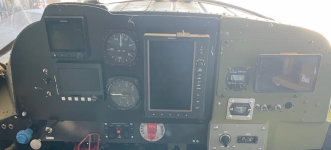Pilot135pd
Well Known Member
I've always owned 12v aircraft so I'm interested in learning the pros and cons of the 12v system over a 24v system. Everyone has 12v chargers and 12v accessories are more readily available, although that's changing and now most everything works from 11 to 30vdc.
1- Would it be just basically changing the alternator, regulator, and starter, or is it more complicated and I would need to change more things?
2- Is there any advantage to keeping the 24v vs changing it to 12v? Since all my avionics work from 11v to 30v, if I keep it 24v and that voltage is basically only used for starting, if I lose my alternator in some remote place out in the back country, I'm thinking it could be hand propped to start and my avionics should last a whole lot longer as the voltage in those batteries slowly decreases from 24v down to something where the avionics would stop working below 11 volts, or am I not understanding how the 24v avionics work?
Here's my setup:
My new-to-me plane has a 24volt electrical system. It used to have an old Russian radial engine and now it has a Lycoming IO-540 (with a modern brand new alternator and starter). It's a VFR plane with bare minimum avionics: G5, MGL engine monitor, radio, portable Garmin 696 and Aera 660, manual flaps and trim. It also has a IO-540 with 3 blade C/S prop.
It currently has two bigass & heavy 12volt batteries that came from an old tech jet that uses 4 batteries and my plan is to replace them with two very much lighter Odyssey 680s. I read in another thread here of at least one RV with an IO-540 using a single Odyssey 680 so I don't expect any starting problems doing that swap.
1- Would it be just basically changing the alternator, regulator, and starter, or is it more complicated and I would need to change more things?
2- Is there any advantage to keeping the 24v vs changing it to 12v? Since all my avionics work from 11v to 30v, if I keep it 24v and that voltage is basically only used for starting, if I lose my alternator in some remote place out in the back country, I'm thinking it could be hand propped to start and my avionics should last a whole lot longer as the voltage in those batteries slowly decreases from 24v down to something where the avionics would stop working below 11 volts, or am I not understanding how the 24v avionics work?
Here's my setup:
My new-to-me plane has a 24volt electrical system. It used to have an old Russian radial engine and now it has a Lycoming IO-540 (with a modern brand new alternator and starter). It's a VFR plane with bare minimum avionics: G5, MGL engine monitor, radio, portable Garmin 696 and Aera 660, manual flaps and trim. It also has a IO-540 with 3 blade C/S prop.
It currently has two bigass & heavy 12volt batteries that came from an old tech jet that uses 4 batteries and my plan is to replace them with two very much lighter Odyssey 680s. I read in another thread here of at least one RV with an IO-540 using a single Odyssey 680 so I don't expect any starting problems doing that swap.





